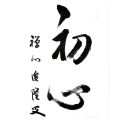It Is the Mind That Sees
“Ānanda, a moment ago you said you saw my fist send forth light. What caused my fist to send forth light? How did I make the fist? And what were you seeing it with?”
Ānanda replied, “The Buddha’s body is like a mountain of precious gems, radiating the color of crimson-tinted gold from the River Jambu. It sends forth light because it is born of purity. When he held up his hand to make a fist by curling his five fingers, I saw it with my own eyes.”
The Tathagata then said, “The sages often use analogies to make a point, now let us use my fist as an analogy. Without a hand, I couldn’t make a fist. Without your eyes, you wouldn’t be able to see. Are they two similar situations?”
Ānanda replied, “Indeed they are. The Buddha’s making a fist can be compared to my using my eyes.”
The Buddha said, “You say they are comparable, but they are not. Why? A person with no hands will never make a fist. But one with no eyes will not be entirely unable to see. Why? If you ask a blind man on the street, ‘Do you see anything?’ He would reply, ‘All that I see in front of me is darkness — nothing more.’ What does it mean? It means that although the blind man sees only darkness, his visual awareness is actually intact.”
Ānanda replied, “It’s true that all a blind man sees before his eyes is darkness, but can that really be what we call ‘seeing’?”
The Buddha said, “Is there any difference between the darkness seen by a blind person and the darkness seen by people with perfect eyesight when they are in a completely dark room?”
“No, there is no difference.” Ānanda replied.
“Then suppose, Ānanda, that the blind person, who has been seeing only darkness, now suddenly regains his vision and sees before him a variety of objects. In such a case, you would say it is his eyes that see. So in the dark room when the person with perfect eyesight suddenly sees before him a variety of objects because someone lights up a lamp, you’d have to say, by analogy, that it is the lamp that sees. However, if a lamp could see, it would no longer be what we would call a lamp. Moreover, if it were the lamp that sees, what would that have to do with your eyes? Therefore, we can conclude that the lamplight simply reveals the objects; it is the eyes that see, not the lamp. In the same way, the eyes simply reveal the objects; it is the mind that sees, not the eyes.”
阿難,汝先答我見光明拳。此拳光明,因何所有。云何成拳。汝將誰見。阿難言:由佛全體閻浮檀金,赩如寶山,清淨所生,故有光明。我實眼觀,五輪指端,屈握示人,故有拳相。佛告阿難。如來今日實言告汝。諸有智者,要以譬喻而得開悟。阿難,譬如我拳,若無我手,不成我拳。若無汝眼,不成汝見。以汝眼根,例我拳理,其義均不。阿難言:唯然世尊。既無我眼,不成我見。以我眼根,例如來拳,事義相類。佛告阿難。汝言相類,是義不然。何以故。如無手人,拳畢竟滅。彼無眼者,非見全無。所以者何。汝試於途,詢問盲人,汝何所見。彼諸盲人,必來答汝,我今眼前,唯見黑暗,更無他矚。以是義觀,前塵自暗,見何虧損。阿難言:諸盲眼前,唯睹黑暗,云何成見。佛告阿難。諸盲無眼,唯觀黑暗,與有眼人,處於暗室,二黑有別,為無有別。如是世尊。此暗中人,與彼群盲,二黑校量,曾無有異。阿難,若無眼人,全見前黑,忽得眼光,還於前塵見種種色,名眼見者。彼暗中人,全見前黑,忽獲燈光,亦於前塵見種種色,應名燈見。若燈見者,燈能有見,自不名燈。又則燈觀,何關汝事。是故當知,燈能顯色。如是見者,是眼非燈。眼能顯色,如是見性,是心非眼。

